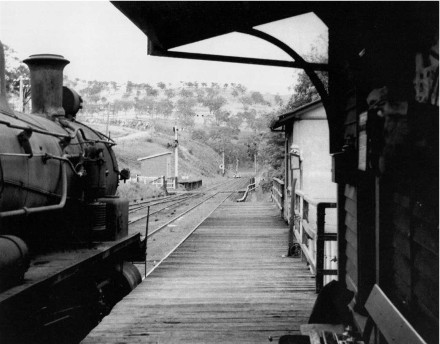Ardglen Tunnel facts for kids
 |
|
| Ardglen station with a train past summit of the Liverpool Range, 26 October 1954 | |
| Overview | |
|---|---|
| Line | Main North railway |
| Coordinates | 31°44′29″S 150°47′48″E / 31.741478°S 150.796634°E |
| Operation | |
| Work begun | 1874 |
| Technical | |
| Construction | Mr. J. Wolfe Mr. William Wakeford |
| Length | 528 yards (483 m) |
| Gauge | 4 ft 8 1⁄2 in (1,435 mm) |
| Lowest elevation | 2,161 feet (659 m) |
The Ardglen Tunnel, also known as the Liverpool Range tunnel, is a very important railway tunnel in New South Wales, Australia. It's considered a heritage-listed site. The tunnel is part of the Main North railway and connects Ardglen and Murrurundi.
This tunnel goes right under the Liverpool Range mountains. It's a key link for trains traveling between Newcastle and Werris Creek. The Ardglen Tunnel was finished in 1877. It is owned by the Transport Asset Holding Entity, a company run by the Government of New South Wales. Because of its historical importance, it was added to the New South Wales State Heritage Register on April 2, 1999.
Contents
The Ardglen Tunnel: A Historic Railway Link
What is the Ardglen Tunnel?
The Ardglen Tunnel is about 528 meters (or 577 yards) long. To reach the tunnel, trains have to climb steep hills for about 10 kilometers (6 miles) on both sides. These hills have a very steep slope, which is challenging for trains.
The tunnel has only one track, meaning only one train can go through at a time. It's the oldest single-track railway tunnel still being used in New South Wales. Because of its single track and the steep hills, this part of the railway line can sometimes cause delays, acting like a bottleneck.
Building the Tunnel
Building the Ardglen Tunnel was a big job! Workers started digging from both ends of the mountain. A new railway line was built from Murrurundi to the east side of the tunnel. This helped bring in all the materials needed for construction.
By June 1876, the two digging teams had met in the middle, and people could walk through the tunnel. Workers then made the tunnel wider and lined it with bricks. Tracks were laid inside, and by July 1876, the construction company's engine could finally pass through. The full railway line to Quirindi opened in August 1877.
Challenges: Smoke and Steep Hills
The Ardglen Tunnel is located at the very top of the steep hills. In the past, when trains used steam engines, the tunnel's narrow shape caused problems with smoke and fumes. The smoke would get trapped inside.
Because of this, very large steam locomotives, like the 60-class Garratt engines, were either not allowed to use the tunnel or had to carry less weight. Luckily, most heavy trains usually went through the tunnel downhill, heading towards Sydney and Newcastle, which made the fume problem a bit easier to handle.
Future Plans for the Railway
Since 2010, there has been a lot more coal being transported by train from areas north of the tunnel. To handle this increase in traffic, new plans are being considered.
These plans might involve either keeping the current tunnel or building a much longer, new tunnel at a lower height (about 200 meters or 656 feet lower). If they keep the old tunnel, they might make the railway line longer in some places to make the steep hills less challenging. This would create a gentler slope, similar to other parts of the railway. The old line could then be used for empty trains going the other way, creating a double track system.
Stations Along the Line
Here are the railway stations located near the Ardglen Tunnel, starting from the south:
- Murrurundi — This station has a medium-sized crossing loop (where trains can wait for others to pass). In the days of steam trains, it had a special depot for bank engines, which were extra engines used to help push trains up the steep hills.
- Pangela — This was a short crossing loop on the steep part of the line, but it is now closed.
- Ardglen Tunnel — This is the highest point on the railway line.
- Ardglen — This station has a medium-sized crossing loop and a railway station. It was made even longer in 2010.
- Kankool — This is a short crossing loop located on the steep part of the line.
- Willow Tree — This station has a medium-sized crossing loop and a railway station. It marks the end of the steep hills.
Why is it Important? (Heritage)
The Ardglen Tunnel is very important because it is the oldest single-line railway tunnel still in use in New South Wales. It's also one of the very few single-line tunnels left. It's a significant part of the landscape, sitting at the top of a ridge that trains approach by climbing steep hills from both directions.
The Ardglen Tunnel was officially listed on the New South Wales State Heritage Register on April 2, 1999. This means it's recognized as a special historical site that needs to be protected. It's considered rare because of its age and continued use.
See also
 In Spanish: Túnel Ardglen para niños
In Spanish: Túnel Ardglen para niños


